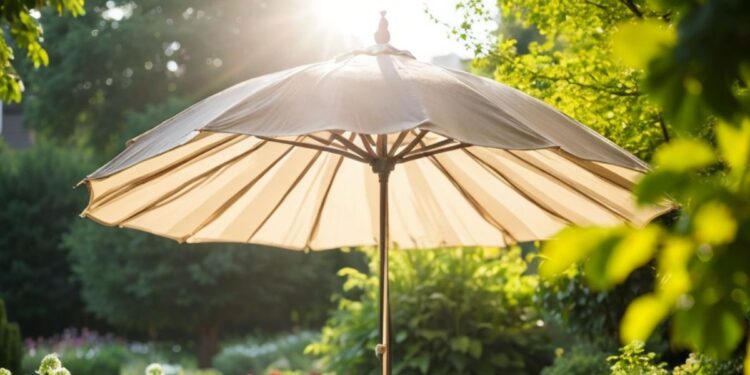What's The Difference Between a Parasol and an Umbrella? | Posh Living Magazine

Key Takeaways -
- Parasols are designed for sun protection and are often used for fashion and ceremonies.
- Umbrellas are built to protect from rain and harsh weather conditions.
- Parasols are generally smaller, lighter, and made from non-waterproof materials, while umbrellas are larger, heavier, and made from waterproof materials.
- Choosing between a parasol and an umbrella depends on your need for sun or rain protection, location, and personal preference.
Knowing the difference between a parasol and an umbrella is important for choosing the right one. A parasol provides shade from sun exposure, while an umbrella protects from rain.
We will explain the main differences between parasols and umbrellas, including their uses, materials, and designs. It will also briefly describe each and highlight their unique features.
Keep reading to understand how these two items differ and to help you choose the best one for your needs. Whether you need sun protection or rain coverage, understanding these differences will ensure you make the right choice.

Historical Background
Parasols and umbrellas have rich histories dating back to ancient civilisations. Parasols originated in ancient China, Egypt, India, and Assyria, primarily used by royalty and the elite for sun protection. These early versions were often elaborately decorated and symbolised status and power.
Umbrellas also have roots in ancient China, where they were crafted from waxed paper and bamboo to protect against rain. Over time, these items migrated to Europe, evolving in style and material.
European designs incorporated sturdier frames and waterproof fabrics, making them practical for daily use and various weather conditions.
Main Differences Between Parasols and Umbrellas
Purpose
A parasol is a small umbrella primarily designed to provide shade from the sun. It is often used for fashion and ceremonial purposes, adding an element of elegance to various events.
Parasols are used as protective devices against sunlight at weddings, garden parties, and other outdoor gatherings.
In contrast, an umbrella is designed to protect from rain, serving a more utilitarian function. Its primary purpose is to keep the user dry during wet weather, making it a practical accessory for everyday use.
Size
Parasols are generally smaller and lighter, making them easy to carry around. This lightweight design makes them ideal for extended use without causing fatigue. However, some patio parasols can be quite large to provide ample shade for outdoor seating areas.
Umbrellas, on the other hand, are typically larger and heavier. They are designed to cover more area and provide extensive protection from rain. The larger size ensures the user stays dry, even in heavy downpours.
Materials Used
Parasols are made from lightweight materials such as canvas, lace, silk, cotton, linen, and plastic. These materials are often chosen for their aesthetic appeal and lightweight nature. Parasols are frequently decorative and not necessarily waterproof, emphasising beauty over function.
Umbrellas use a waterproof material (like nylon and polyester). These materials are selected for their durability and weather resistance, ensuring the umbrella effectively shields the user from rain and withstands harsh conditions.
Shape and Design
Parasols feature a smaller, lightweight, and delicate construction with a straight shaft and decorative handles. They often have elaborate designs and embellishments, such as lace trims and colourful patterns, adding to their aesthetic appeal.
Umbrellas, in contrast, have a sturdy and practical construction. They usually come with a curved handle for easy grasping and carrying.
Their simple design focuses on functionality, prioritising practicality and durability over decoration. This makes umbrellas ideal for daily use in various weather conditions.
Types of Parasols and Umbrellas
Types of Parasols

Parasols come in various types, each suited for different uses and environments:
- Free-standing parasol: Has a central pole and is commonly used in patios and gardens. It provides ample shade for outdoor seating and can easily move to different locations.
- Cantilever parasol: This design features a side pole, allowing for unobstructed space underneath. It is ideal for larger areas and offers flexible shading without the interference of a central pole.
- Tilting parasol: Its adjustable angle enables flexible shading. It can be tilted to block the sun from different directions, making it perfect for outdoor activities.
- Beach parasol: Portable and designed for use on sandy beaches. It is lightweight and easy to carry, providing necessary shade while enjoying a day by the sea.
- Balinese parasol: This highly decorative item is used for fashion and style. It often features intricate designs and vibrant colours and adds an exotic touch to any outdoor setting.
Types of Umbrellas
Umbrellas come in various types, each designed for specific purposes and environments:
- Traditional umbrella: A classic umbrella has a metallic or wooden shaft and a microfiber canopy. It is a versatile and timeless choice for everyday rain protection.
- Wind-resistant umbrella: Made from strong materials with a double-layer cover. It is designed to withstand strong winds without inverting, providing reliable protection in stormy weather.
- Golf umbrella: Features a straight handle and is built to withstand harsh weather conditions. Its large size provides extensive coverage, making it ideal for golfers and outdoor enthusiasts.
- Paper umbrella: Paper umbrellas are used in Chinese culture to protect from sunlight. It is often beautifully painted and used in traditional ceremonies and cultural events.
- Beach umbrella: Large and accommodates groups at the beach. It provides extensive shade, ensuring comfort and protection from the sun for multiple people.
Functionality and Usage
Protection
Parasols protect from harmful UV rays, keeping users cool and comfortable in sunny weather. They are ideal for providing shade and reducing heat during outdoor activities, ensuring comfort and protection from the sun.
Umbrellas shield from rain, snow, and hail, making them practical for various weather conditions. They provide essential protection during inclement weather, ensuring users stay dry and comfortable in rainy, snowy, or stormy conditions.
Fashion and Cultural Significance
Parasols symbolise elegance and status in various cultures and are often used in traditional ceremonies, weddings, and photography. They add a touch of sophistication and cultural richness to these events.
Umbrellas, on the other hand, are practical accessories suitable for all genders and ages. They hold cultural significance in many rituals and traditions, demonstrating their importance beyond mere functionality and highlighting their role in daily life and special occasions.
When to Use a Parasol vs. an Umbrella

So, when is parasol better than umbrella to use? Here are some scenarios where one would be more suitable than the other:
Time of Day
Use a parasol for sunny afternoons when you need protection from the sun's rays. They provide shade and keep you cool. Umbrellas are better suited for rainy weather, offering protection from rain, snow, and hail.
Location
Parasols are ideal for shaded, tree-covered areas where you might need extra sun protection without the risk of rain. In contrast, umbrellas are perfect for open spaces where you must stay dry during unexpected downpours.
Your Preference
Choose a parasol for stationary activities like picnics or outdoor events where you can enjoy consistent shade. Umbrellas are more suitable for on-the-go protection, ensuring you stay dry while moving around in wet weather (1).
Frequently Asked Questions
Can a Sun Umbrella Be Used as a Parasol?
While a sun umbrella can provide some shade from the sun, it is not specifically designed for this purpose like a parasol. Umbrellas are typically heavier and less decorative than parasols. Additionally, umbrellas may not offer the same UV protection level as parasols.
What Are the Most Common Damages to Parasols and Umbrellas?
Parasols often suffer from fabric tears, fading, and damage to their delicate structures. Umbrellas commonly face broken ribs, bent shafts, and damaged handles. Both items require careful handling and proper storage to prolong their lifespan.
Can I Use a Patio Parasol at the Beach?
A patio parasol at the beach is possible, but it may not be the most convenient option. Patio parasols are generally less portable and harder to secure in sandy conditions than beach umbrellas. Beach umbrellas are designed to be lightweight and easy to set up on the sand.
How Do I Fix Broken Wooden or Metal Ribs on My Rain Umbrella?
To fix broken wooden or metal ribs on your rain umbrella, first, identify the damaged rib. Use wood glue and clamps to secure the broken pieces together until dry for wooden ribs.
For metal ribs, use a strong adhesive or duct tape to temporarily hold the pieces, then consider replacing the rib or taking the umbrella to a professional repair service for a more permanent fix. Regular maintenance can help prevent future damage.
Conclusion

Understanding the differences between parasols and umbrellas helps you choose the right tool for your needs. Parasols provide elegant sun protection, ideal for fashion and ceremonial purposes, while umbrellas offer practical rain protection for everyday use.
Whether you're seeking shade on a sunny day or shelter from the rain, selecting the appropriate parasol or umbrella enhances your comfort and style. Consider your specific requirements and preferences to make the best choice.
Sources -












